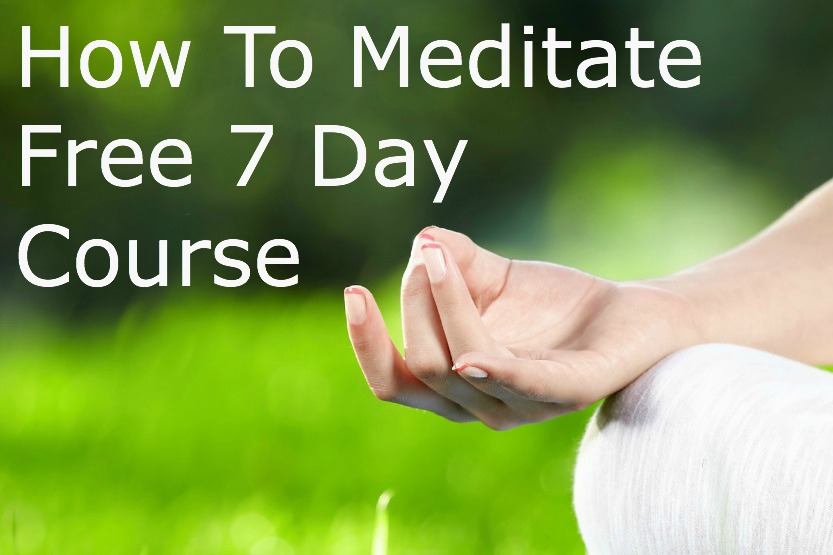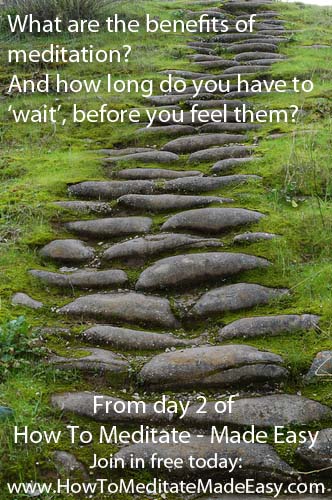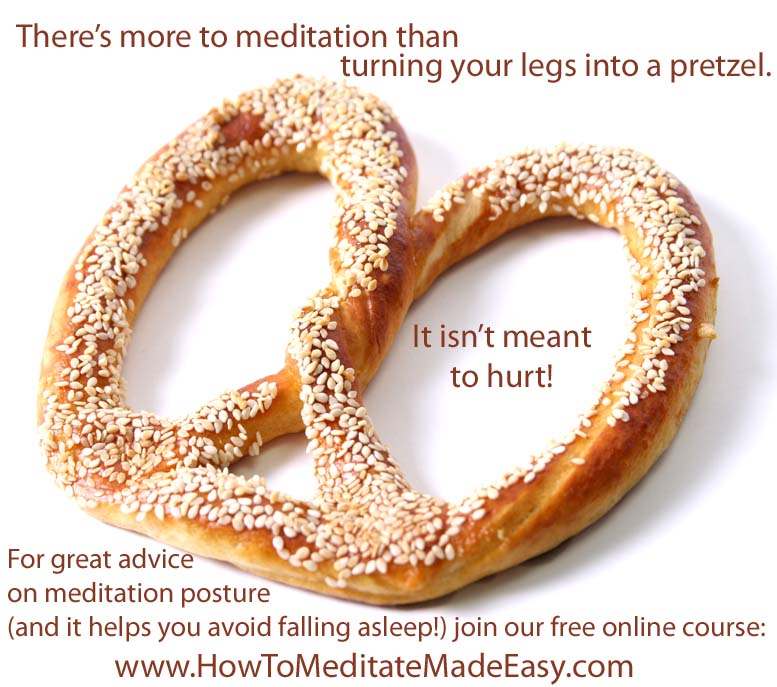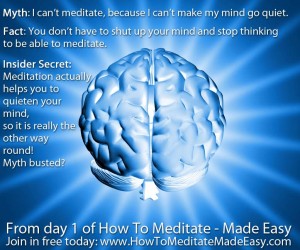[vc_row type=”full_width_background” bg_position=”center top” bg_repeat=”no-repeat” bg_color=”#0a5282″ scene_position=”center” text_color=”light” text_align=”left” top_padding=”7″ bottom_padding=”7″][vc_column width=”1/1″][vc_column_text]
Today I’m sharing the insider secrets that make the difference between a ‘nice idea’ and a long-term meditation habit.
[/vc_column_text][/vc_column][/vc_row][vc_row type=”in_container” bg_position=”left top” bg_repeat=”no-repeat” scene_position=”center” text_color=”dark” text_align=”left”][vc_column width=”1/1″][vc_column_text][heading]How are you getting on? Woo hoo! Day 6!
How did you get on with yesterday’s Monkey Mind techniques? I’d love to here from you – here’s where you can share: Dealing with your pesky Monkey Mind.[/heading][/vc_column_text][/vc_column][/vc_row][vc_row][vc_column width=”1/1″][vc_column_text]Today I’m sharing with you the little-known truths (that nobody tells you!) for turning an ‘occasional’ meditation into a habit you look forward to – for the 7 days and beyond – nuts and bolts and more!
How To Create Your Meditation Habit
Discover the insider secrets to fast track creating any new habit.
I’ll start today’s instalment by making a statement that might, on the surface, seem really obvious, but when you let it settle, it holds the key to creating a habit:
The easiest way to create habit is to choose to do it.
I know that probably sounds stupid, but it’s amazing how often we try and create a habit, when we haven’t really bought into the change we want to make. We are doing it because somebody else tells us to or we think we ought to.
The easiest way to create a habit is to really understand why you want to do it (that’s why we covered it back on day 3).
When you have bought into your ‘why’, then all you need to do is create a rhythm in your day; a routine; something that will remind you to do it and something that will help you celebrate the fact that you did. It also helps if you keep track of the progress you are making.
The 3 steps to a new habit:
[/vc_column_text][/vc_column][/vc_row][vc_row][vc_column width=”1/3″][image_with_animation image_url=”11968″ animation=”Fade In” img_link_target=”_blank” img_link=”https://www.facebook.com/photo.php?fbid=10152057229241238″][/vc_column][vc_column width=”2/3″][vc_column_text]Inspiration is what gives us the idea to get started.
Motivation really gets us going.
But it is routine and consistent efforts that, together, create the change.
Ancient Sanskrit (the language in which many of the ancient meditation practices were originally taught) has a special word for this consistent effort: abhyasa. Without abhyasa, even the most enthusiastic student is unlikely to see tangible progress. So motivating yourself to make your meditation time an integral part of your daily routine is crucial for achieving the results you are looking for – and learning to meditate.
I like to think of abhyasa as doing what I know needs to be done, even when I don’t feel like it. And I always feel better afterwards.
Abhyasa – dedication; commitment; despite distractions.
You won’t make progress on your meditation journey without it.[/vc_column_text][/vc_column][/vc_row][vc_row][vc_column width=”1/2″][vc_column_text]
Quick Exercise:
Think of an example in the past where you have motivated yourself to do something – and to keep going with it.
- How did you motivate yourself?
- What worked for you?
- What didn’t work?
- How did you remind yourself to keep going?
- What kinds of incentives worked?
- How did you create and then establish the change in your routine?
- How could you apply that to help yourself with your meditation practice?
How about sharing your answers?[/vc_column_text][/vc_column][vc_column width=”1/2″][image_with_animation image_url=”11966″ animation=”Fade In” img_link_target=”_blank” img_link=”https://www.facebook.com/photo.php?fbid=10152057216681238″][/vc_column][/vc_row][vc_row][vc_column width=”1/1″][vc_column_text]Apply what you know works for you and then, over time, as your skill improves, you’ll find you really enjoy your ten minutes of meditation. You’ll find yourself looking forward to it. You’ll crave it, as your personal space and quiet time. And if you miss it, you’ll feel it throughout your day. When you get to that stage, the meditation is then driving itself.
Once you have created the rhythm – the routine – the change becomes a habit.
An easy way to create the meditation routine is to do it at the same time, in the same place, each day. Then your body and mind come to expect it. And if you need to set yourself a reminder – be it an alarm or a piece of paper on the fridge door – do it! It’s ok.[/vc_column_text][/vc_column][/vc_row][vc_row type=”full_width_background” bg_position=”center top” bg_repeat=”no-repeat” bg_color=”#0a5282″ scene_position=”center” text_color=”light” text_align=”left” top_padding=”7″ bottom_padding=”7″][vc_column width=”1/1″][vc_column_text]
Creating a new habit is as much about remembering to do it as it is about the new techniques.
[/vc_column_text][/vc_column][/vc_row][vc_row][vc_column width=”1/1″][vc_column_text]Once you see positive results, your new habit will become self-sustaining. While you are getting to that point, the routine and the habit are the key.
Picking the same point in your daily routine to meditate gets you anchored into the rhythm. If excuses and interruptions are getting in the way, deal with them! You can – you know you can. Nothing is impossible!
For example, if you had a habit of buying a doughnut every time you walk past the baker at 11 o’clock in the morning, your body and mind would become conditioned to expect it. Your body and mind will even give you signals, to remind you to go past the baker, should you forget to on a particular day.
It Is The Same With Meditation.
If, at the same point in time in our routine each day, we go to the same place, sit in the same way and say to ourselves, “This is my meditation time,” it doesn’t take long before your body and your mind start remembering what comes next. They’ll remember that it feels good and they’ll start nudging you to meditate.
It’s knowing how to create the habit that makes the difference between a ‘nice idea’ and a strong, sustainable meditation or mindfulness practice. And that’s the whole point of the way I teach meditation – including this 7 day course!
So the rhythm, the routine and the habit are what create a long-term meditation practice – and that is what will get you the results you are looking for.
In the world of psychology and NLP, this is known as anchoring. It’s an incredibly useful technique. If you’d like to find out more about it, here’s a bonus article:
“How To Use Anchoring To Help You Remember To Meditate.”
So there you have it – some insider secrets to help you make your meditation habit last.
![]() I’m curious: which tips resonated for you today? Which will you be applying? How might you get round your old blocks? I’d love to hear from you! Here’s where to share: How to create a lasting meditation habit[/vc_column_text][/vc_column][/vc_row][vc_row][vc_column width=”1/1″][vc_column_text]I hope you enjoy your meditation today.
I’m curious: which tips resonated for you today? Which will you be applying? How might you get round your old blocks? I’d love to hear from you! Here’s where to share: How to create a lasting meditation habit[/vc_column_text][/vc_column][/vc_row][vc_row][vc_column width=”1/1″][vc_column_text]I hope you enjoy your meditation today.
And I’ll be back tomorrow with your final instalment on this 7 day course, with insider Secrets and expert tips to help you keep your meditation habit going, long-term, including how to create your own personal action plan for keeping the habit going!
With love, Namaste,
![]()
P.S. If you’re serious about creating a long-term, life-changing, sustainable meditation habit and want to dive in more deeply, then you’ll love my 10 week meditation programme. In it, we cover the whole ‘how to create the habit’ challenge in much more detail. We’ll look more deeply at how easily excuses can get in the way – and how you can get past them, once and for all.[/vc_column_text][/vc_column][/vc_row]





 Meditation isn’t supposed to hurt. It’s not about turning your legs into a pretzel.
Meditation isn’t supposed to hurt. It’s not about turning your legs into a pretzel.


 Deep relaxation is about relaxing the body and mind – and re-energising. You are aiming to fully engage the body’s parasympathetic nervous system, to be able to fully let go and relax, physically, mentally and emotionally.
Deep relaxation is about relaxing the body and mind – and re-energising. You are aiming to fully engage the body’s parasympathetic nervous system, to be able to fully let go and relax, physically, mentally and emotionally.
 Week 1 –
Week 1 – 









